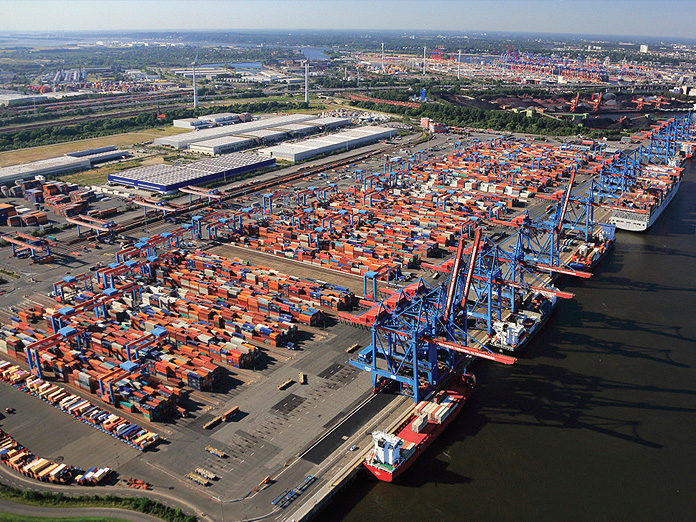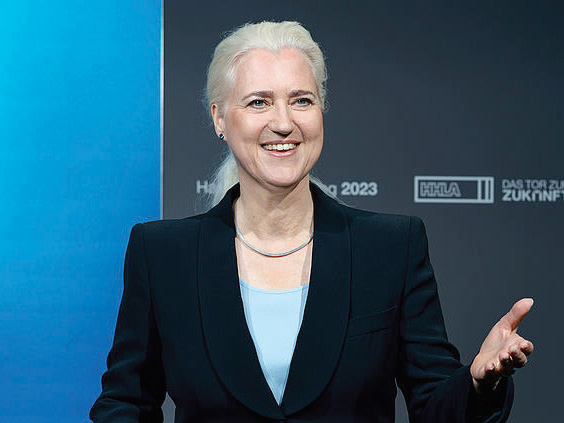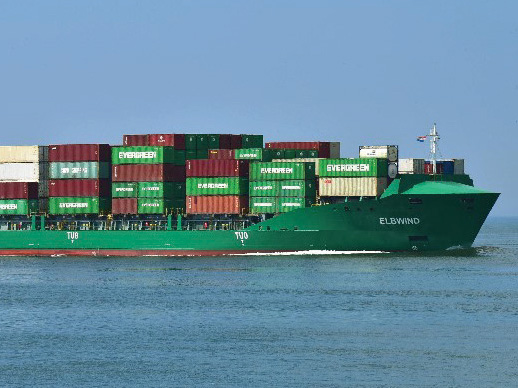Port of Hamburg resorted to using feeder ships, instead of trucks, to transfer containers between terminals to reduce congestion.

European ports facing acute container congestion pressures are resorting to new and creative ways to reduce this paralyzing factor that is also plaguing other ports of the world.
German logistics experts have been raising alarm in the past over the container traffic congestion caused by large trucks before the terminals. This problem was severe at Hamburg port, the German sea hub that is often touted as Germany’s “gateway to the world”. The port has taken a number of measures to reduce the truck congestion by transferring the containers per feeder ships
Inner-port transportation by water, instead of by trucks, was made possible under an agreement between the software house Dakosy and the Dakosy Interessengemeinschaft Hamburger Linienagenten (DIHLA), the data communication system for the Port of Hamburg, and the Danish Unifeeder shipping line; the latter which operates in Hamburg with smaller ships, will now not only transport containers to the port but also within the port itself.
Tackling Truck Congestion
The Port of Hamburg has been striving to reduce the truck congestion for some time; this problem became acute because a fourth of all containers are not immediately transported from the container terminal where they are then loaded on another ship. This so-called transshipment process (transfers of containers between large container ships and feeder vessels) involves some 3.3 million containers per year; however, a significant part of transshipment is still transported by road from one terminal to another.
“(Feeder) transshipments can take several thousand containers off the road each year,” DIHLA managing director Alexander Geisler said.
The project involving feeder ships to move containers, instead of trucking containers over the roads between terminals, was actually launched on November 1, 2022; the use of feeders would also help reduce carbon emissions. Besides reducing congestion caused by the juggernaut trucks – the problem is exacerbated by a shortage of truck drivers - Hamburg port officials, appealing to the growing public environmental consciousness, emphasize that the use of feeders for transshipment will also reduce carbon emissions.
Florian Pein, a senior executive at Unifeeder, maintained that some 50% of the transshipment traffic will be operated by feeders, instead of trucks, in the future. Pein highlighted the fact that being Northern Europe’s largest feeder operator with 85 terminal calls every week in Hamburg, Unifeeder could offer enough resources for additional container transportation within the port.
Dakosy, DIHLA and Unifeeder coordinated to develop the software process, implementing a new module for integration into Dakosy’s Port Community System.
The DIHLA also reinforced the point that container transportation by feeders between Hamburg port’s container terminals were a prudent mode of inner port transportation; it was the “right approach” that provided relief to the road infrastructure in the port, besides being environment-friendly.

HHLA Looks to Improve Stakeholder Coordination
The Hamburg Port and Logistics Company, also known by its German acronym HHLA, seems to have reconciled itself to disruptions in supply chains and delays in container traffic. Angela Titzrath, HHLA’s chairperson, addressing an online shareholders’ meeting in mid-June, urged shipping lines, forwarding agents, the railway, shippers, and the authorities to improve their coordination.
The HHLA has faced uncertainties since some time over the disruptions in shipping schedules caused by COVID lockdowns in China and the Ukraine war. Containers had piled up at the terminals, with freighter ships often not loading the containers. At the same time, export or import consignments are delivered either too early or too late, Titzrath said. This resulted in containers clogging the system and the traffic operations. She also said that because of the war there was a shortage of more than 100,000 truck drivers from Ukraine, resulting in bottlenecks and shortage of cargo space leading to price hikes.
Titzrath added that transportation was impeded because construction jobs carried out by the authorities were often not announced in time, resulting in massive congestion in which trucks are stuck for hours. Furthermore, the recent port strike had delayed clearance of containers in Hamburg.
But Titzrath added that the HHLA management expected a moderate increase in container traffic and interior transportation, as also in turnover. This was also the result, particularly, of higher container storage charges which the HHLA has been collecting because of weeks of ship delays.
Meanwhile, talks with the rival Eurogate had been ongoing since months over a merger of container ports in North Germany. Titzrath reported that there had been no new developments on that issue. She was, however, confident that a memorandum of understanding for the port alliance would materialize soon.
Hamburg port, Germany’s largest and Europe’s third largest container port, has four container terminals with an annual handling capacity of some 12 million TEU. All container terminals are equipped with integrated rail terminals that are meant to strengthen Hamburg’s leading position among rail ports in Europe.

Container Traffic Impacts Rail and Road
The container congestion at the port has also impacted other transportation modes such as rail and road. With ports receiving increasingly larger container vessels, aimed at transporting more containers, the container terminals are glutted with large numbers of containers, causing delays and cramped warehousing conditions. Forwarders and truck drivers are being urged to arrive at the terminals outside the peak hours, for example, in the evening or even on the weekend to obviate excessive waiting time for the truck drivers and also enhance the port’s productivity.
But many engaged in the maritime trade are also worried that the ports’ profitability and earnings could be impaired with the onset of a recession that is currently looming on Germany; the ports fear that they could be sucked into the country’s present economic quagmire.
With recession raising its ugly head in Germany, Hamburg port started 2023 with a slowdown in cargo traffic. During the first quarter of 2023, the port handled 28.1 million tonnes of cargo, down 10.2 percent compared to the year-earlier period, according to the information released by the port.
Container traffic had declined by 16.9 percent to 1.9 million TEU. The port’s marketing arm Hafen Hamburg Marketing (HHM) attributed this decline to several factors: “Continuing geopolitical tensions, EU’s economic sanctions against Russia, high inflation, low purchases by consumers worldwide and high stocks in warehouses have impacted cargo traffic in European ports,” it said. The figures for 2022 showed a declining trend in cargo traffic recording 119.9 million tonnes, down 6.8 percent compared to 2021. Container traffic had declined by 5.1 percent to 8.3 million TEU.
However, Axel Mattern, the HHM chairman, expects a recovery in traffic in the course of this year. The difficult economic situation was also reflected in the current traffic figures of all north German ports. Hamburg port was not the only one to be hit by the current situation, he said.

_-_28de80_-_58820516bd428ab3fd376933932d068c43db9a4a_lqip.jpg)




